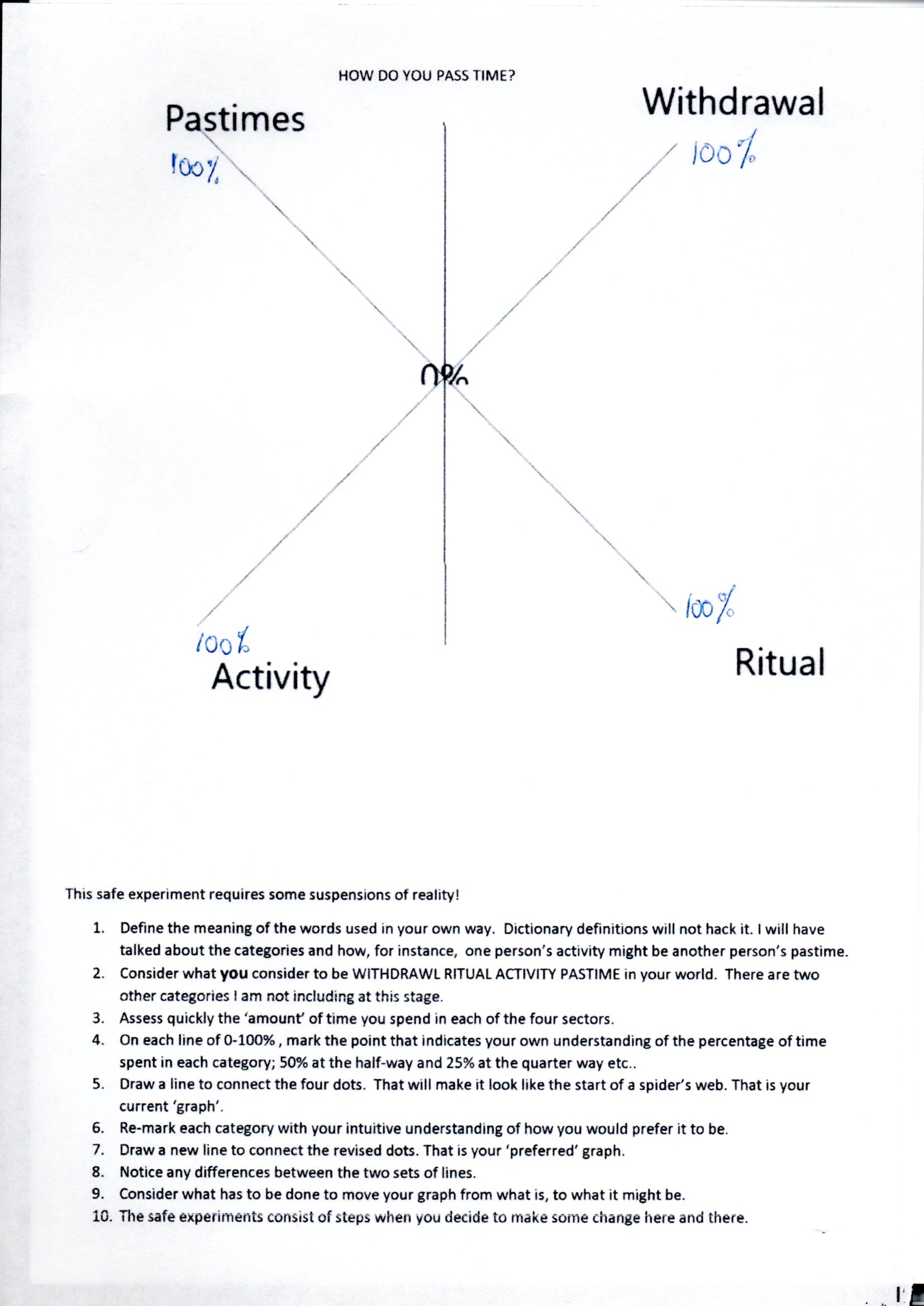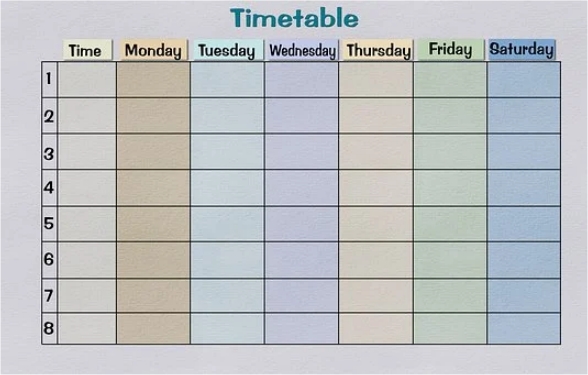I’d like to consider how we structure our time through the day. My picture, above, shows one way; it divides the day into sections, as a diary divides our week.
The Transactional Analytic (TA) model suggests a different approach based on what is happening at different times of the day or night. TA offers six descriptions for what happens in any 24 hour period. These categories are:
WITHDRAWAL
… this is time spent alone or, indeed, alone in the crowd. It is not simply having no-one near us; it can be in a withdrawn state in, say, a meeting or a party.
RITUAL
Doing something on auto-pilot, simply because it is what you always do. For instance, I have a routine for preparing my breakfasts most mornings. It is now so familiar I can complete it – half asleep!
Rituals are not just what might go on in an organised religion. Rituals are things we do repetitively until we no longer need to think much about them. Some help us run our day efficiently even if others provide limited benefit or pleasure.
ACTIVITY
….. this is purposeful behaviour intended to get a known result, e.g. preparing a meal or driving a car from A to B. One person’s activity might be another person’s ….
PASTIME
….. as these are similar to activity, but ‘pastiming’ is behaviour with a less obviously focused result. Usually, it’s just for fun. Sports usually qualify, unless you are a professional, because it’s a fun thing. There are plenty of other things you could do, but you choose to play that particular sport. Most leisure activities fall into this category.
INTIMACY
…… this is the tricky one. Here, intimacy does not refer to the obvious – sexual intimacy. Instead, it is a subtle and fleeting experience, often lasting a micro-second. Eric Berne, the founder of Transactional Analysis, told us we’d be lucky to obtain 15 minutes of intimacy throughout our entire life span!
Nevertheless, it is an important category as the rewards obtained from intimacy are highly prized by us humans. They can help us deal with our small defeats in a disproportionate way.
GAMING
There is a sixth time-structure, GAMES-PLAYING with a page of its own!
You can do further research on these categories of time structuring via sites such as: https://manchesterpsychotherapy.co.uk/time-structuring/
A SAFE EXPERIMENT ON YOUR TIME STRUCTURE
PART ONE
On this page, I use just four of the categories listed above. You can consider the two missing categories later.
Consider how you spent your time over the last day, or even last week. It is highly unlikely that you will have spent all your time – 100% of your time – in one of the time structuring divisions, as listed above.
Therefore, mark the point on the chart where you intuition tells you how you spent time on each of the four elements. If in doubt, give each ‘arm’ 25% of the time just to see what that shape looks like. If you are using pencil, it is then possible to adjust your shape to your actual experience.
In that example, 25% would be an equal amount of time spent in each element. You are likely to notice, however, that there is one element that tends to dominate your daily or weekly timetable. There may be another which appears rather neglected.
When you join up the points, you will get a ‘spidergraph’, a picture that helps convey how balanced, or unbalanced, your time structuring is at this time.
It is then just one step to ask the usual question I raise so very often: how might you prefer it to be.
That takes you back in the world of small, safe experiments or life planning.

Its subjective; only you can say how you structure your time
When doing this safe experiment, please be clear that this will be a subjective experience. Therefore, it is best done quickly and intuitively. Thinking about it a lot will make you realise its a difficult task to define terms.
There are a lot of if’s and but’s to defining what actions go in which box!! Rely less on calculation, or consultations of your diary. Have a rapid and impulsive shot at it. After all, it’s only a first shot and you can redo it or refine it later on, if you feel that might help.
If it helps, use percentages in each box and do not be too troubled if they do not add up to 100%! That said, if there is a large difference, say, under 90% or over 110%, consider what that outcome is telling you about the way you spend your time.
You can put in as much thought into this as you like afterwards.
EXPERIMENT: PART TWO
When you have finished the Part One experiment, look at the results and notice if anything surprises you or has made you curious. Make further notes, including information on specific events:
WHAT you were doing ….
WHEN you were doing it ……
WHERE you were doing it …..
WITH WHOM were you doing it ….
and, rather crucially, how might you have preferred it to be?
Depending on the conclusions you draw, what safe experiments can be designed to make a small difference next time around?
Making a record
By using this experiment, you are starting to create a CBT Thought Record; a systematic way in which you can relate any thought (or image) to people, times, situations and our current mood. More importantly, it gives us the chance to examine the evidence that seems to justify our thought. When a Thought Record works well, it helps us to challenge our evidence and even identify contrary evidence.
What a good way to start to make changes! Changing thoughts can lead to changing actions. Changing actions can lead to a change in feeling (or the level of feeling as measured by a Subjective Unit of Discomfort (SUD).
As ever, take time to notice the results when an opportunity arises to do that something ‘a little bit different’ This may include intake of liquids in the evening, attention to how you prepare for bed (bathing, teeth cleaning and tablet taking), and ways you try to settle immediately on turning the light out. Few of us go to sleep as soon as our head hits the pillow.
By now, you will notice my emphasis on taking action. Now there are times when this might not be so helpful and, night-time, when you are preparing for sleep, is just one such time. If this is relevant to you, then consider my comments about sleep management.
You may want to tell me about your own experiences making changes to your own space and time. You can choose to let me use your experiences, or not. There is never a mention of names!!
Here is a way you can do that:
